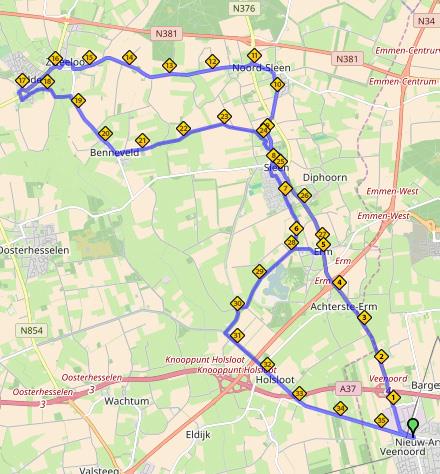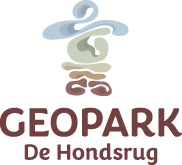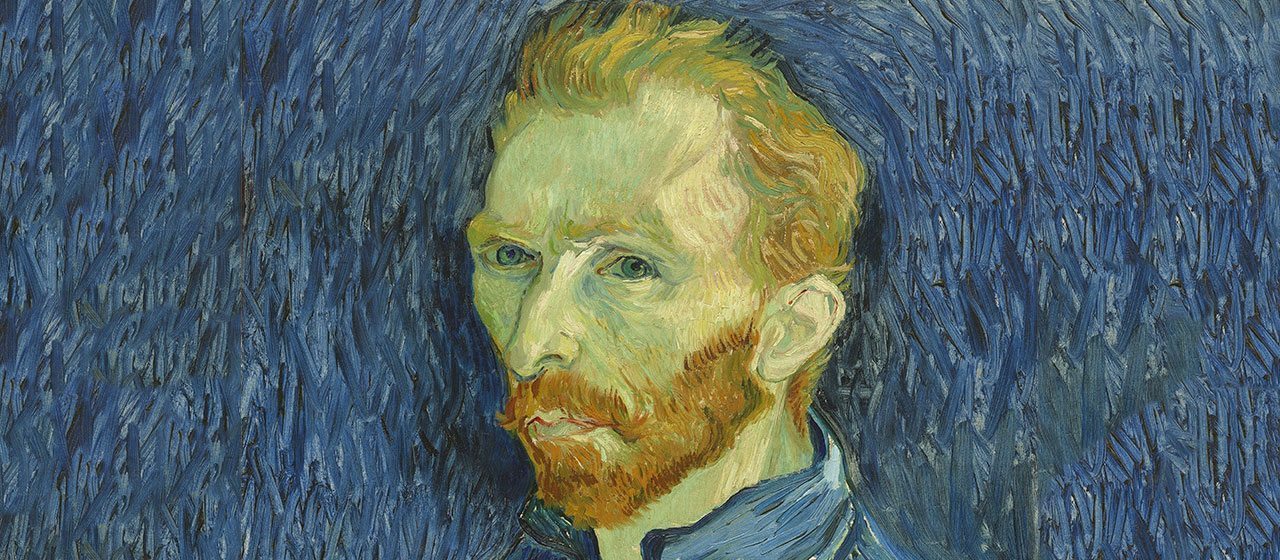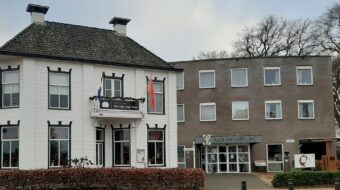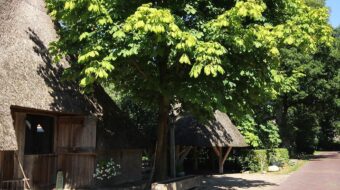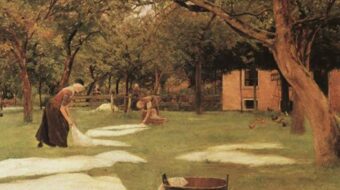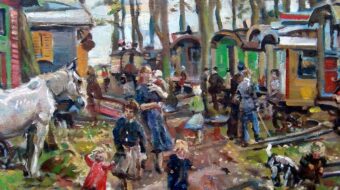Met Vincent van Gogh rond Zweeloo
- 35 KM
- 3 uur
Dear Theo,
‘I ‘d love to tell you about a trip to Zweeloo, the village where Liebermann stayed for a long time making studies for his paintings’
Thus Vincent van Gogh begins his letter to his brother Theo. Vincent rode with inn-keeper Scholte on a farm cart through the area. Van Gogh was one of the many artists who travelled to the Hondsrug region in search of the beauty of the Drenthe landscape. On this cycle route you can accompany Vincent on his trip in and around Zweeloo.
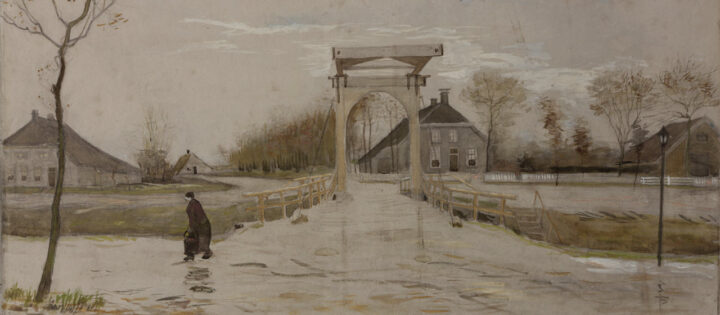
The Van Gogh House
The Van Gogh House is the only house in the Netherlands open to the public in which Vincent actually lived and worked. All visitors to the house are taken on a personal guided tour which includes the café and Vincent’s bedroom and also watch a short film. Many articles and gifts are available in the shop. The reception area is home to the Expedition Gateway to ‘Artists on the Hondsrug’. Information about the nine hotspots in this story line gives visitors an impression of what they can see at each location.
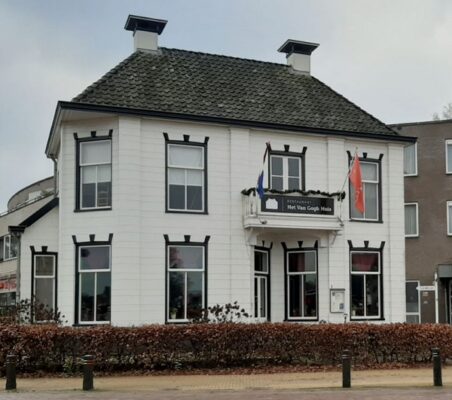
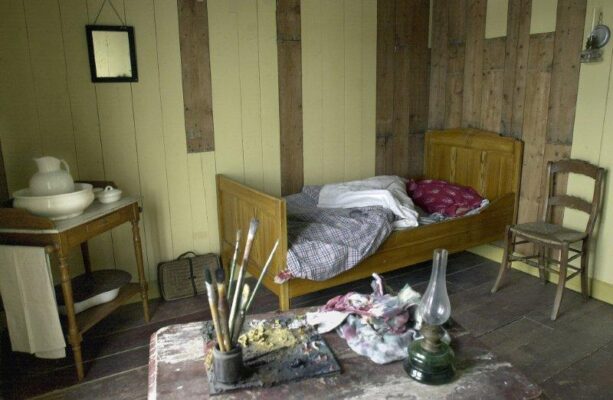
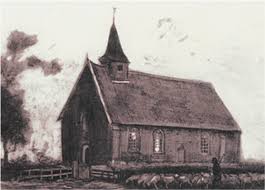
Nodes route
- 1Starting point: The Van Gogh Huis
From the Van Gogh House cross the bridge and immediately turn left along the north bank of the canal called Verlengde Hoogeveensche Vaart (dug around 1860), in the direction of the village of Erm. Cycle by the mill and follow the Boerdijk, then go straight ahead at the first and second roundabouts (N B: take the cycle path to the left of the road). The name of the road changes to Horsingerend.
At the next two roundabouts keep going straight ahead towards Erm.Schilderijlijst brug (Picture frame bridge)
Looking through the picture frame you will see today’s view. Under the frame is an illustration of Vincent’s painting showing what the surroundings looked like in 1883, as seen by Van Gogh from the window of his room.Nooitgedacht Mill in Veenoord
The first mill was built on this site in 1861. In 1904 it burned down and another mill was built on the same spot. This also burned down in 1916, and the present mill was then brought here to Veenoord from Hankate in Overijssel.- 2Erm
In the village of Erm go left at the first junction into the Dalerstraat. Then take the first road to the right (De Hoek). Next take the second road to the right (Hellingenweg).
Scholte’s wagon
You are now cycling on the route which Van Gogh took in 1883 in inn-keeper Scholte’s wagon. To your left are the meadows with wooded banks and right the old agricultural fields or ‘essen’.- 3Oldengaerde
Turn left at the end of the road (Oldengaerde) and then into the Heirweg at the bend. Cycle as far as the junction with the Broekveldstraat en then turn left. After about 50 metres go right and then via the Drostenstraat to the “De Hoop” mill.
Old road
The Heirweg is a very old road, a part of the old connection between Coevorden and Groningen, along which armies marched in the past. The house on the left at Nr. 36 Heirweg is the former poor house belonging to the Reformed Church in Sleen. Next to it lies an enormous prehistoric boulder.
De Hoop corn mill
“De Hoop” is a corn mill in the Drenthe village of Sleen. The mill was built in 1914, using parts from the “De Gunst” mill in Amersfoort. It is a ‘Stellingmolen’ or platform mill and it replaced a mill which had burned down earlier that year. The corn mill was restored in the period 1953-1956 and again in 1976. De Hoop is equipped with a pair of millstones. You can visit the mill if the flag is flying.- 4Schultestraat Sleen
Turn right at the mill into the Schultestraat and then left at the junction (Bannerschultestraat). Next take the first road to the right (Brink) and go left at the junction. Pass the old town hall and continue until you reach the Reformed church.
Church in Sleen
The Reformed church was built at the beginning of the fifteenth century. The tower is the highest church tower in Drenthe with a height of 59 metres and 37 centimetres above the ground. In 1867 the tower burned down after a lightning strike. Because there was no money, it was not until 1923 that the tower finally gained a new steeple. Van Gogh wrote about this: ‘an old stump of a tower in a little churchyard with earth banks and a beech hedge’- 5Menso Altingstraat, Sleen
Go right at the end of the road (Menso Altingstraat) and after about 50 metres you will see on your right the café-restaurant “De Deel”. Follow the Menso Altingstraat out of the village, go straight ahead at the roundabout (Markeweg) and you will see on your left the prominent and picturesque “Albertdina” mill in Noord-Sleen. Keep following the Markeweg and keep to the left at the junction (Dorpsstraat). At the roundabout go straight ahead in the direction of Zweeloo.
The ‘Albertdina’ mill in Noord-Sleen is a so-called ‘grondzeiler’. That means that the sails reach down to the ground. The mill was built in 1906 using parts from the demolished ‘Apollo’ corn mill from Usquert in Groningen. It replaced an earlier mill built on the same spot in 1904 which had burned down. These days the mill has a sails in the old Dutch style, with wings twenty-three metres long. The mill is equipped with one pair of millstones and is now and again operated by volunteers. The present owner is the municipality of Coevorden.
- 6The Elsiessteen (Elsie's Stone)
At the end of the village a sign on the right directs you to a couple of hunebeds, about 400 metres from the road. If you like, you can go and take a look at them. After about two kilometres you reach the boundary with the old municipality of Zweeloo, now part of the municipality of Coevorden. To the right of the cycle path here is an erratic boulder called Elsiesstien (Elsie’s Stone’).
The legend of The Elsiesstien
The following story is told about this Elsiesstien. A long time ago, a number of people were travelling in two farm wagons across the heath fields in the direction of Noord-Sleen. A storm threatened and already flashes of lightning could be seen in the distance. Suddenly the horse on the first wagon reared up. The farmer was only just able to calm the horse down in time and then drive on. The horse on the second wagon also began to rear up at the same spot. The waggoneer sprang down and grabbed the horse by the bridle. By the light of a flash of lightning, one of the women in the second wagon saw something strange lying by the side of the road. They stopped to look and it turned out to be a young woman of about 20, covered in blood. She was good looking and had long black hair. A knife was stuck in her breast … The authorities in Sleen were notified and they quickly brought help. The body lay just on the boundary between the villages of Zweeloo and Sleen. Where had the murder been committed? Nobody recognized the young woman. After further investigations a farmer from Aalden was found who said that her name was Elsie. She had earlier come to his door begging and he had helped her out of pity. She had come all the way from Gelderland with travelling magicians. The murderer was never found, and both Zweeloo and Sleen tried to shift the cost of burying the body from one to the other. The local magistrate finally decided that the murdered woman should be buried in the churchyard at Zweeloo and the costs borne by the people of Sleen. Elsie’s stone was later placed at the spot where the body was found, in order to mark the boundary between the two villages.- 7The princess of Zweeloo
After about two and a half kilometres, just before you cycle into Zweeloo itself, you come to the burial place of the ‘Princess of Zweeloo’ on your left. Follow the road and you will see on your right the splendid little thirteenth century church of Zweeloo with its quaint tower.
The Princess of Zweeloo
The grave of the ‘Princess of Zweeloo’ is an exceptionally wealthy grave dating from the early Middle Ages. The grave finds can be viewed in the Drents Museum in Assen.The little church tower at Zweeloo
The turret of the old church is covered with wooden shingles. A pagan sacrificial stone lies in front of the entrance to the church. Van Gogh wrote about this church: ‘I came to a small old church, exactly like the l’Eglise de Greville in the painting by Millet in Luxemburg; instead of the farmer with a spade in that painting, here was a shepherd with a few sheep standing by a hedge. Instead of the view to the sea in the background, here was a sea of young corn, a sea of furrows instead of waves.’- 8The small church of Zweeloo
From the church you follow De Wheem into the village and pass the old smithy (Nr. 2 on the right). Then go right on the Wheempad and straight on at the junction. Then take the first crossing to the left (Klooster). On your left here you will see five panels by the German painter Max Liebermann. After 50 metres go right on the cycle path. On your right in the garden of a bungalow – the former residence of the burgemeester – stands an old linden-tree. According to tradition, it was under this tree that Van Gogh sat to take a rest in 1883.
Van Gogh hoped to meet Max Liebermann here, but he had already left. Here Vincent made the drawing of an old woman at the spinning wheel. The ‘Kunstenaarscafé’ (Artists’ Café) is one of the The Hondsrug Geopark hotspots in the storyline about Art & Artists on the Hondsrug.
- 9Hoofdstraat (Main Street) Zweeloo
At the end of the cycle path you cross the mainstreet (Hoofdstraat) and go left. After about 50 metres you will see on the left the former café Mensingh, now Bistro Tante Sweel. Follow this road, keeping right at the fork, and cross over a bridge. You are now in the village of Aalden (Aelderstraat). Follow the cycle path to Nr 61 and then turn right (Gelpenberg). Go left at the next junction (Molenwijk).
At the end of the paved road stands the ‘Jantina Helling’ mill. At the ‘paddenstoel’ 23144 (toadstool – a cycle sign) follow the road towards Aalden. At the next junction cross over the Aelderstraat and go straight ahead into Oud Aalden. At the following junction go straight ahead following the sign for cycle point 67. On your right you will see the coffee and pancake house of ’t Hoes van Hol-An
Aalden mill: This mill has stood here in this place since 1652, at Molenwijk 13 in Aalden.
- 10Old Aalden
The moss roofs of the houses, stables and sheepfolds, which Van Gogh so lyrically described, can still be seen in Oud-Aalden. The ancient village is full of Saxon-style farmhouses and is designated a protected site. One of these farmhouses is now a pancake house called ’t Hoes van Hol-An.
Follow the road and go straight ahead at the next junction, which is cycle point 67, follow the route for Klencke). Keep right at the next two junctions (following the Klencke route again) and you come to the Koemarsendrift. Turn right at the end of the street towards Benneveld. Go left at toadstool 24925 and then right again at toadstool 24924, still heading for Benneveld.
Farm wagon: You are now on the route which Van Gogh travelled in the other direction on the farm wagon with his innkeeper, Mr Scholte.
- 11From Benneveld to Sleen
Having arrived in Benneveld you turn left after Bennevelderstraat 37 (Kampweg) towards Sleen. You enter the town of Sleen via the Haarmaatsdijk, the Bommertsweg and the Groningerweg. Turn right at the crossroads into Polweg and then take the first left (Koepen). At the end of the street go right (Brink), which turns into the Bannerschultestraat.
Sleen
Rechts ziet u een natuurreservaatje met enkele percelen grasland, omzoomd door elzenhout. Even later doemt links voor u de molen Noord-Sleen op en rechts de ranke toren van Sleen, met weer rechts daarvan molen De Hoop.- 12Sleen
On your right you will see a small nature reserve with meadows fringed by alder trees. A little later the mill of Noord-Sleen looms up on your left and on your right rises the slender tower of Sleen, with the ‘De Hoop’ mill again to its right.
Cycle through the village along the Bannerschultestraat and go right at the end of the street (’t Eng) on the cycle path towards Erm. At the Sleen-Broekveld road sign go right (Oldengaerde) and then turn left at the following junction (Hellingenweg).
Churches in Sleen: On your left stood the old Protestant church, and on your right now stands the Reformed Church.
- 13The Ermerzand
At the junction of three ways go right and you will come to a recreational area called ‘Het Ermerzand’.
Go left at the junction (Jongbloedvaart). At the end of the street go left (Oosterhesselerweg) and cycle along the ‘Verlengde Hoogeveensche Vaart’canal. Continue under the viaduct and cross the bridge at the junction, following the route along the canal on the south bank.
Keep on the cycle path wherever possible.
Arriving in Veenoord you will see the Van Gogh House again to your right.- 14Zwaaikom (turning basin), Veenoord
There is a bend in the road around a so-called ‘zwaaikom’ or turning basin in the canal. This is a place where the canal widens into a large pool so that ships which are longer than the canal is wide can turn around. A little further on you will notice that the water level of the canal is higher than the land. On the south side of the wood is the railway which lies on a raised dike. It was somewhere in this area that Vincent sketched his ‘Landscape with Trees in the Peat’.
